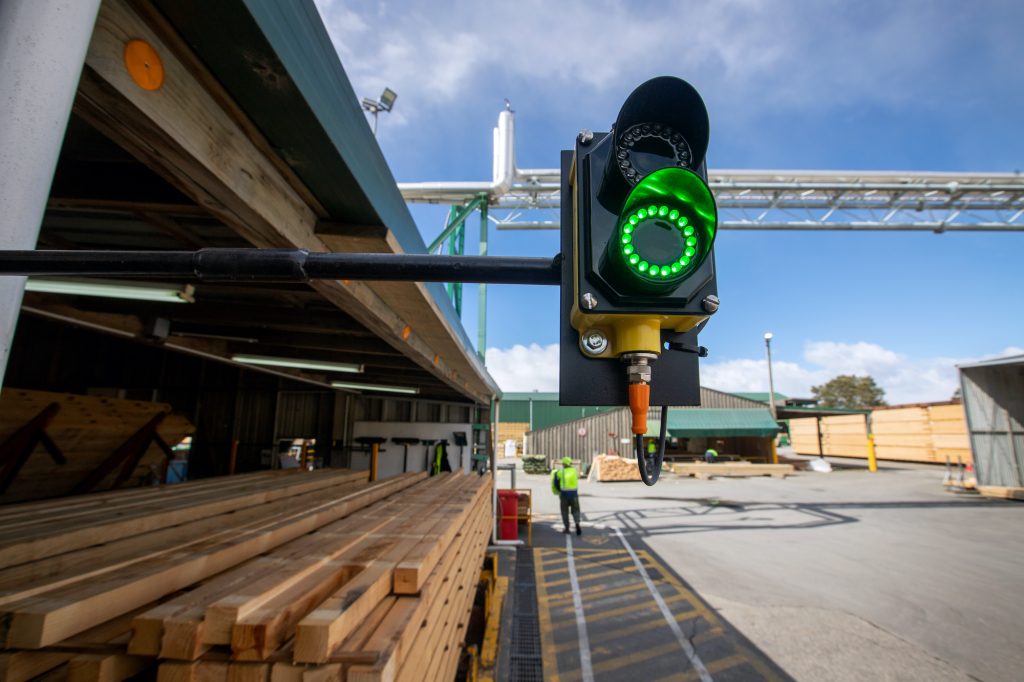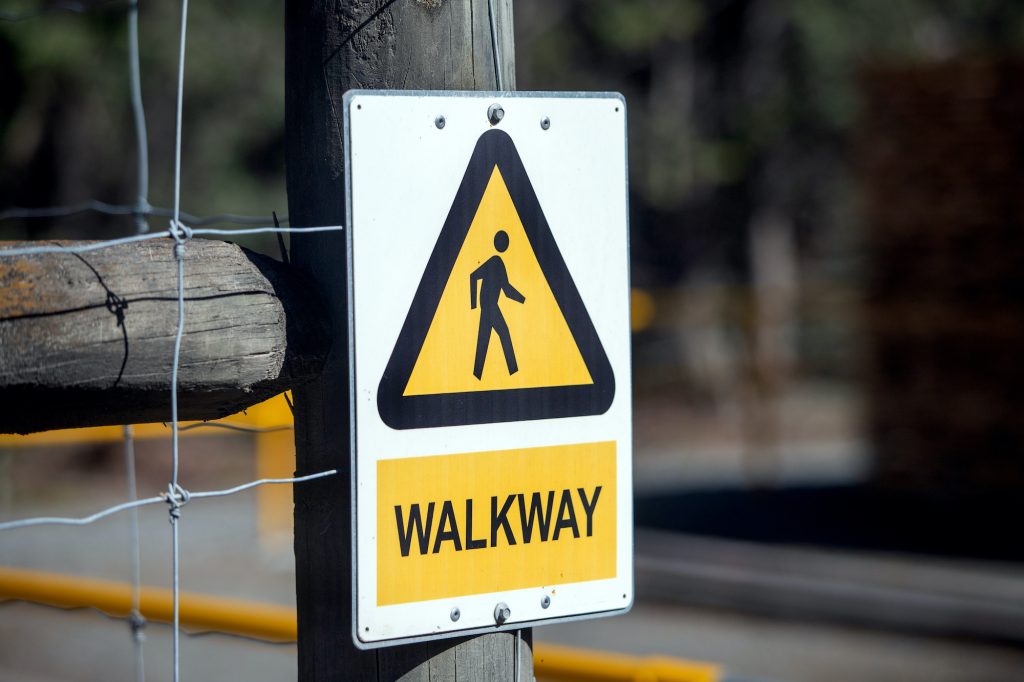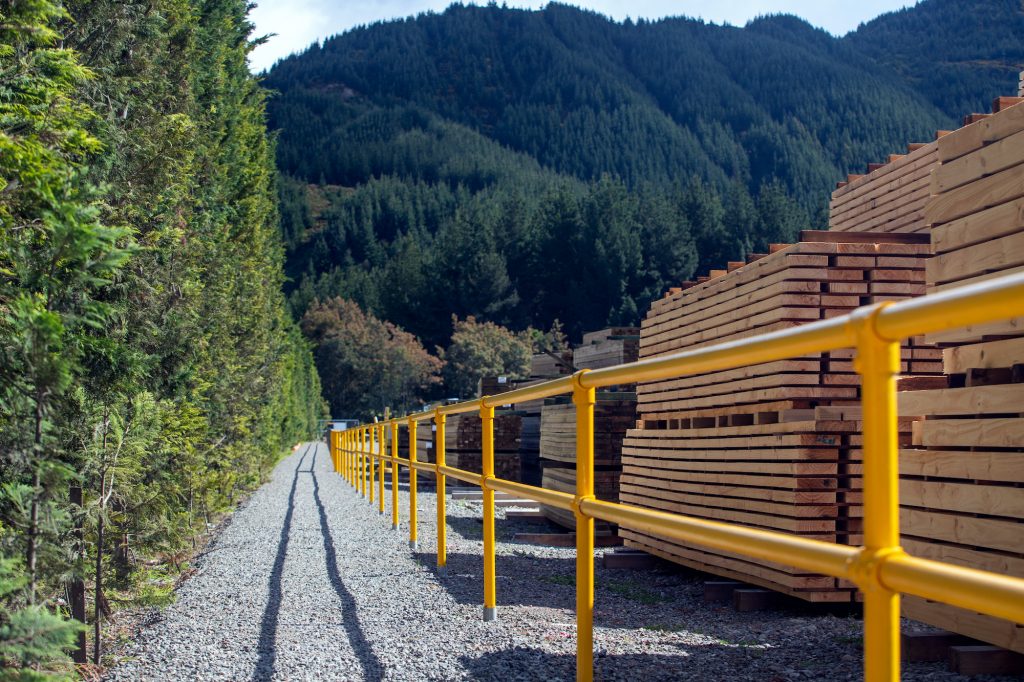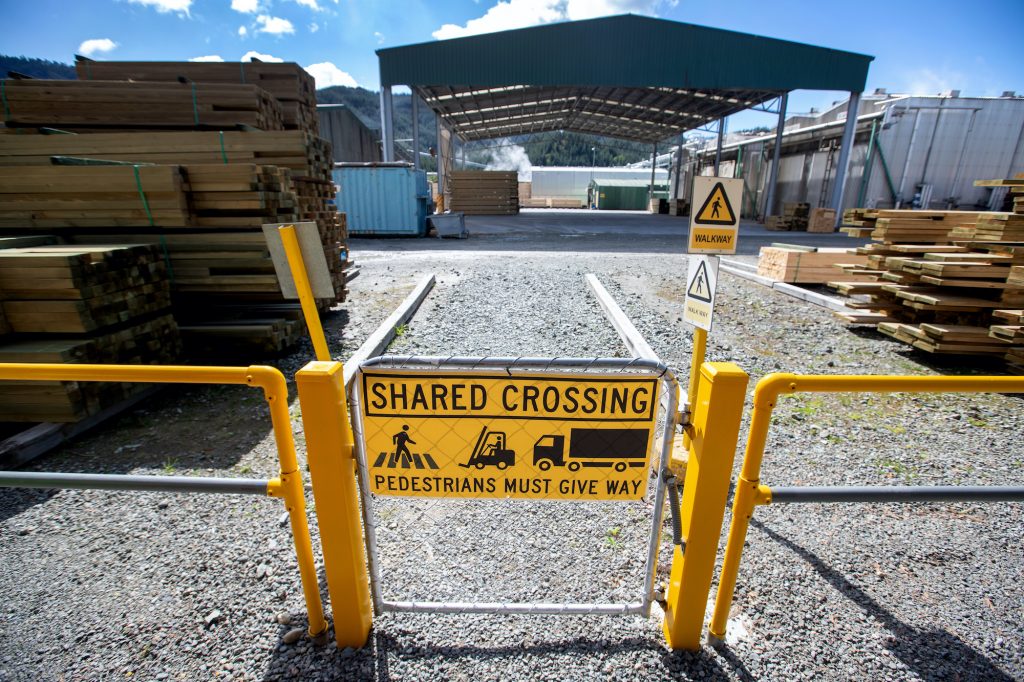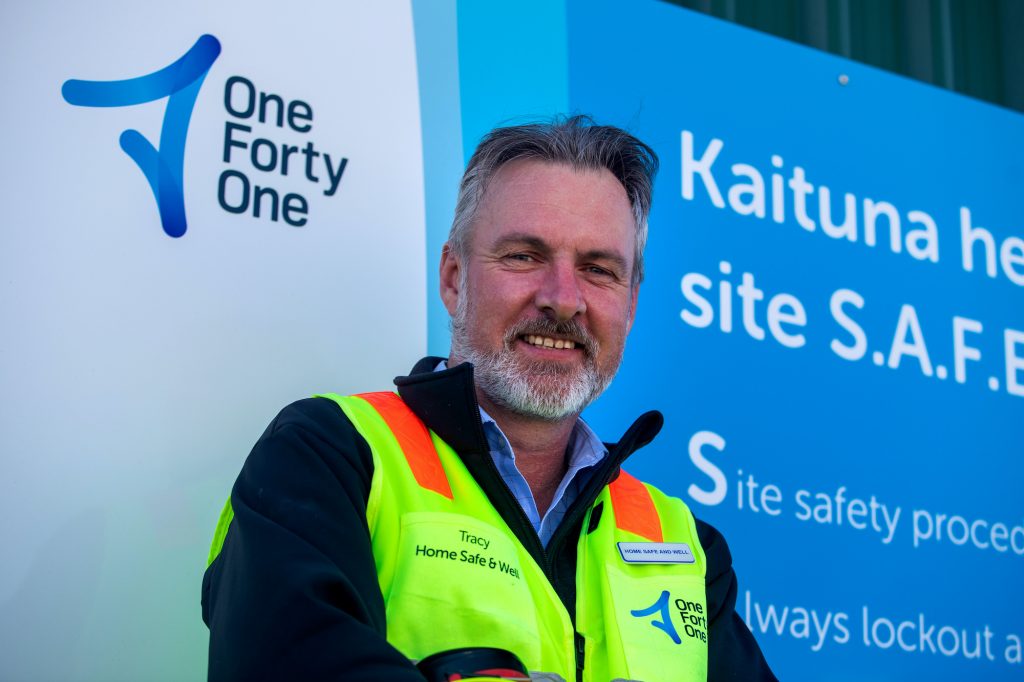
BY SANDRINE MARRASSÉ | PHOTOGRAPHY TIM CUFF
Improving safety and maintaining high safety standards is critical for OneFortyOne, a forest and timber industries business with softwood plantation forests and sawmills in New Zealand and Australia. Safety for the company’s people, contractors and partners is the top priority. Physical changes to the workplace and changes in behaviour lead to improved safety, however the real driver of sustained safety improvements for all is creating a cultural shift.
Health and safety always comes first at OneFortyOne’s Kaituna Sawmill, says Kaituna General Manager Tracy Goss. Tracy and his team are creating a shift in health and safety culture at the mill by striving for improvement and involving the whole team so that there is a shared accountability for everyone to go home safe and well at the end of each working day. Tracy says it’s just “the tip of the iceberg” on their journey of improvement, culture change, and development but they can already see the shift having an impact on their people, on their productivity and on the workplace as a whole.
The initial step OneFortyOne took was to invite independent external and internal assessors into its Kaituna sawmill to observe and recommend improvements and enhancements to systems and processes.
The assessors’ areas of focus were leadership, engagement, new government legislation and compliance, and risk assessment. Several reports were prepared, including a safety and guarding [barriers] report, a safety behaviour and site culture report, and a safety direction and implementation report.
A shift in on-site culture
As part of the improvement process Kaituna introduced an auditing system that defines areas of focus and effectively targets areas of opportunity within the operation.
“We integrated people, maintenance, plant and equipment into the review process,” says Tracy. “We have very specific measures for performance but the culture element is difficult to measure and it’s hard to determine whether or not you have the right culture.
“Safety isn’t just about compliance,” he says. “Safety is about everything we do day-to-day. A safe site is a productive site so what we’ve also seen is an increase in productivity due to the safety improvements that have been made.”
Tracy and the team understand that the development of a team process requires empowering individuals to bring forward their ideas, with the confidence that they will be heard and responded to.
“Ultimately, we can’t do anything without our people, so the most important thing has been to engage them at every step of the change process. By doing this we have empowered them to take ownership of certain elements of the project and this has enabled them to be part of the process. For instance, as we’ve gone through and put new physical barriers throughout the site, all of a sudden people’s perception of risk has started to change. We’re starting to see people applying awareness of risk on a day-to-day basis. They’re being empowered to speak up and say ‘hey, that’s not right’.
“The culture shift is slowly developing and is offering people the opportunity to challenge each other in a ‘courage to intervene’ way. This means that our people can both look after each other and hold each other accountable. They’re taking an action or raising an issue because it’s the right thing to do and they’re invested in reducing risk. You need a trusting environment to affect this type of change so that people feel comfortable enough to bring these issues forward and so that they can trust that the business is going to react in an appropriate way.”
Hayden Watty, an apprentice timber machinist who started working at Kaituna as a stacker five years ago, describes a massive shift in culture at the mill. “We look after our team mates, but not only that, we are all talking about safety more.”
Hayden says that the changes he has experienced make him feel more valued, and that it is clear that production is second to safety. The changes to the forklift safety and the guard rail changes in particular have made a big impression on Hayden.
“When I first started here there was more of a culture of ‘she’ll be right’,” Hayden says. “The culture is a really big thing for me because once upon a time it was rush, rush, rush, whereas now we’re told slow down, work out the hazards, and then fix it. It’s all changed now and everyone looks after each other.”
Home safe and well – a powerful pledge
OneFortyOne’s company-wide Home Safe and Well programme is a key platform for culture shift.
Launched in January 2020, the programme invites team members, including contractors visiting the company’s sites, to sign a pledge, and people who have signed have also received a badge to wear to indicate they have endorsed the pledge.
“The pledge is to ourselves, to our families, and to one another,” says Tracy Goss. “It’s a way of signalling to everyone that we are working towards our common goal of doing all the things in our control to go home safe and well every day.”
New ways of involving the team
Two other key initiatives have been increasing the length of the induction process to a full week for each employee, and introducing a voting system to elect site-wide health and safety representatives.
“About a year ago we changed how we appointed the Health and Safety Representatives (HSRs) by calling a site-wide election,” says Kaituna Sawmill Health and Safety Facilitator, Cilla Ivory. “People that were interested in becoming HSRs had to submit a bio and photo with their registration of interest, and then everyone voted via a single transferable vote system.
“Since then we have two key safety meetings each month – a health and safety site-wide meeting and a Health and Safety Representatives meeting where we look at different projects that we will be focussing on. Each area now has their own Health and Safety Representative that they can go to with any issues or ideas that they want raised at the monthly meetings.
“There’s been a huge change,” she says. “Individuals are coming up with ideas and they’re recognising hazards and risks. They will question it themselves and raise it with the HSRs. We’ve always had HSRs, but until now there hasn’t been this level of engagement with them.”
The change has been very well received by Kaituna staff members, including Bob Ward, (a member of the dispatch team) who put his hat in the ring for the election and got voted in as a HSR about a year ago. Bob says it’s important that he was voted in by his colleagues and he thinks this has helped to shift the culture in a positive way. “I’ve never worked for a company so into their safety, and I think that’s helped by the long induction process for new people starting work here. On a day-to-day level for every process you have to go through the safe operating practices so you’re aware of how things work. It’s very good.”
A very visual and constant safety reminder
Ultra-bright yellow railings that guide staff and visitors on pedestrian-only walkways through the Kaituna site are a very visual reminder of where to walk, and new 1.8m guarding fences throughout the mill also create an instant, tangible reminder of the fact that there is heavy duty machinery and plant nearby.
“It’s all designed to slow you down in a good way, by creating a constant visual reminder that there are hazards,” says Cilla.
“Another visual change that visitors might notice when they walk around the site is that on the other sides of the fence lines where we store stacks of timber, the stacks closest to the walkway are now only two packets high, the second row is three high and then the third is four high. That way, people are only ever walking closest to the shortest stack of timber.
“Carrying on with the high-impact visual theme, while we’ve had signage for a long time, there is now an extra emphasis site-wide on new, more eye-catching signage.”
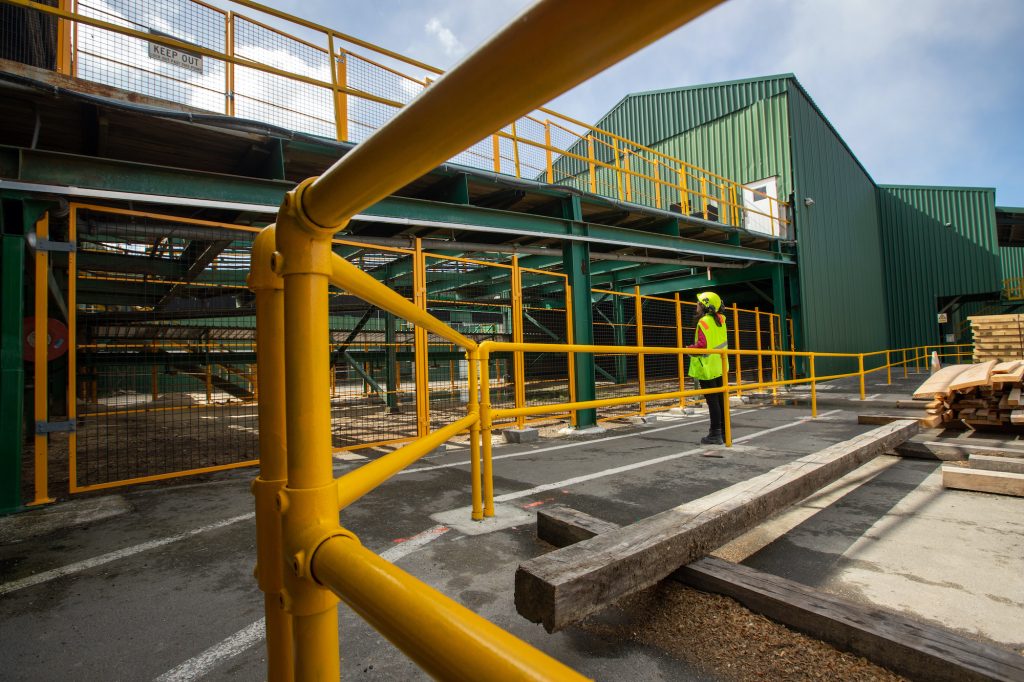
Increased safety around forklifts and moving plant
Safety around forklifts was identified early on as a significant issue. “We started by looking at the issue of mobile plant vs pedestrians and involved our site health and safety representatives,” says Cilla. “It was a really positive exercise and everyone had information to give.”
Cilla says that the key area of focus was forklift separation from pedestrians.
“Some of the walkways used to cross over areas where forklifts went, so now we have guided walkways that keep the pedestrians away from forklifts and other moving plant,” says Cilla. “In a couple of really busy forklift locations where there is also intermittent pedestrian activity there are sensor-activated super bright LED traffic lights at safe points to alert people that a forklift is in the vicinity. They must wait in the safe area until the light turns green before proceeding.”
There have also been improvements that have provided clear, highly visual reminders of the exclusion zone around forklifts that benefit the drivers and pedestrians.
“We now have red lights on the side of the forklift that show a three-metre exclusion zone around the forklift. The machine has to be turned off and the forklift driver has to be out of their machine and come over to the pedestrian to talk to them. The exclusion zone is particularly visible when it is darker, during the early morning hours, and this striking visual reminder of what three metres around a forklift actually looks like has proven to be extremely effective.”
Forklift operators at the mill have embraced the changes. “They do feel that it’s keeping pedestrians out of their operational areas and that their work space is safer. They really appreciate that people are respecting their work zone.”
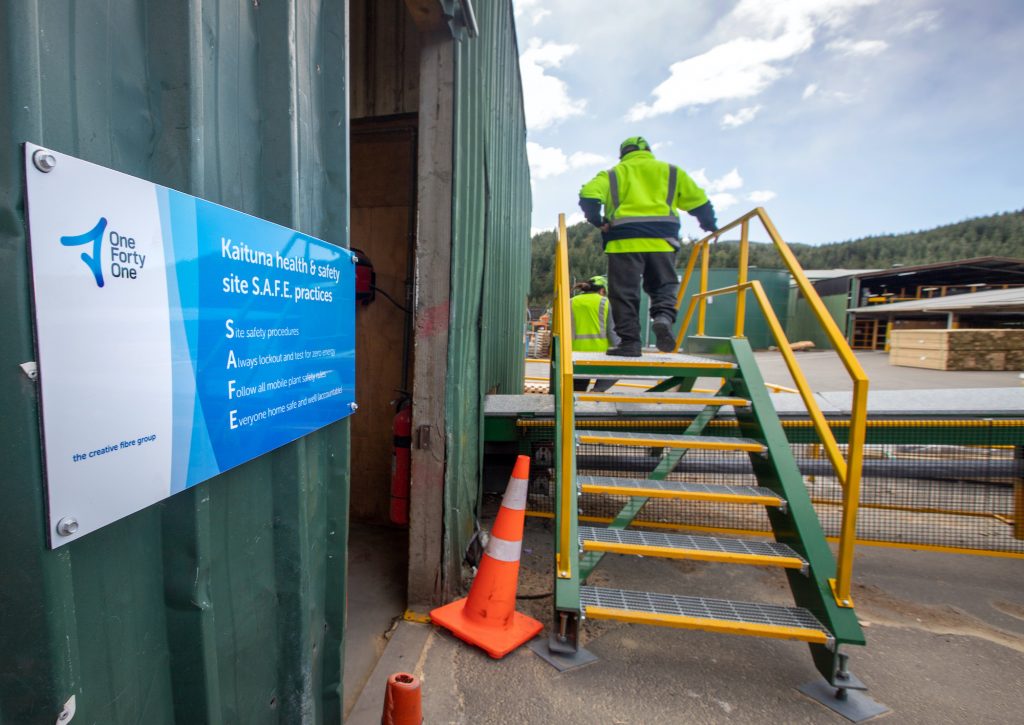
Increased productivity
There is an old adage – you have to go slow to go fast – and this is at the heart of increased productivity at the mill despite the increased safety measures and improvements.
“You have to solve problems at their root cause,” says Kaituna’s Green Mill Manager Chris Lambert. “It’s human nature to try to solve or find a ‘work around’ for small problems by effectively utilising what’s in front of us. One of the aspects of our safety work is to stop the ‘work arounds’.”
Increased fencing and guarding has meant that changes have been implemented that address core problems.
“For example some areas in the mill might be areas where the timber traditionally bunches up or moves off its runners,” says Chris. “The fix has always been for someone to manually stand on the sidelines and flip the timber with a metal pole. The new, increased safety measures have meant that we have looked at ways of improving the performance of the machinery itself so that it no longer allows timber to become bunched up or flipped on the wrong angle. As a result, it’s safer and we have actually been smarter because we fixed the root problem.
“Not all of these improvements have been an easy journey. When you’ve got a way that you’ve done something for years and then it gets taken away from you it can be a bit frustrating. That’s until you work out as a team how to do it, and then it feels easier.”
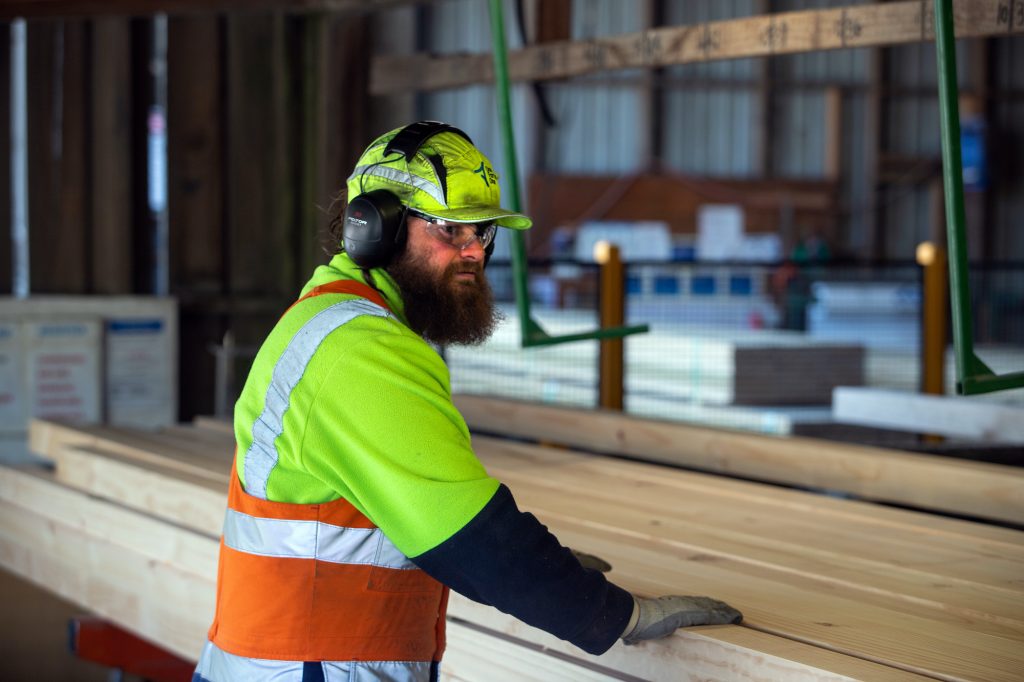
Constantly evolving
Continuous improvement in health and safety is a constant process in a sawmill environment but the Kaituna team are confident that they have the full support of their colleagues to keep everyone safe and well at work and protect everyone’s right to go home to their families at the end of each working day.
“The team at the mill are continuing to look at ways to reduce and eliminate critical risks, to record what they’re doing, and to encourage a culture that keeps themselves and contractors visiting the site safe,” says Tracy Goss. “We need people working together to make this happen and we’re proud of the collaboration here at Kaituna. Safety is never a job that’s “finished”, and we keep ourselves in check by remembering that we are always only as good as our last day’s performance.”

